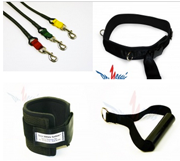Other sports
We also work with athletes in sports other than those highlighted on our site. These sports involve some of the same skills as the primary sports we work with.
No matter your sport, there is skill and exercise technique to be analyzed and improved.
Some recent MMA athletes have worked with us to perform more effectively with improved quickness and explosiveness not only in their movements, but also in punching and kicking.
Triathletes have improved their running speed and distance and transition phases from the swim to the bike and bike to the run.
All athletes can be improved with all or some of the following:
- Skill perfection for more success on the field
- Increased speed in skill execution
- Increased running speed
- Greater strength in skill execution
- More explosive power in skill execution and in movement
- Greater hitting and punching power
- Greater quickness in specific movements.
- Greater throwing power and accuracy in specific skills
- Greater skating speed and power
- Faster acceleration
- Sharper and faster cutting actions
Mixed Martial Arts
MMA requires a multitude of skills in order to be successful. You must have the skills to execute good punches as in boxing, execute offensive and defensive moves when on the mat and kicking skills when applicable. More specifically you must have the ability to:- throw different punches with maximum force and speed
- Repel and evade punches
- Execute a quick first step forward when attacking
- Execute a quick first step backwards when avoiding a hit
- Push your opponent off or away from you with great force when on the mat
- Produce aerobic and anaerobic energy as needed for recovery, prevention of fatigue and to have more energy during the bout.
- Exert arm or leg force in various directions to counteract or attack your opponent.
- Execute quick movements in the ring
- Display explosive power in punches and kicks
Plyometrics
What Is Plyometrics?
Plyometrics, a method for developing greater speed and explosive power, is now very popular in the athletic and fitness fields. It is based on the muscle/tendon stretch-shortening concept. This means that when a muscle/tendon is placed on involuntary forced stretch, it will contract (shorten) with greater force. More specifically:- The forced stretch creates great tension in the muscle and tendon. The greater the load during the forced stretching and the quicker the load is applied, the greater is the energy accumulated.
- Energy for the reverse action is given back when the muscle and especially the tendon, undergo shortening to enable the action to occur.
- Jumps are used most frequently in plyometric training. On a jump down the loading forces a stretch and in the jump up, the muscle/tendon complex shortens.
- The most significant aspect of plyometrics is how quickly the action is executed, usually in 0.15 – 0.20 seconds.


